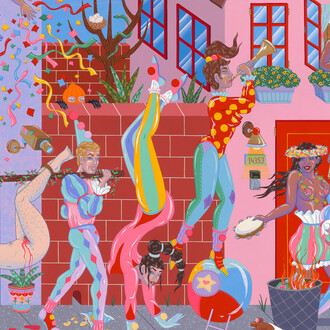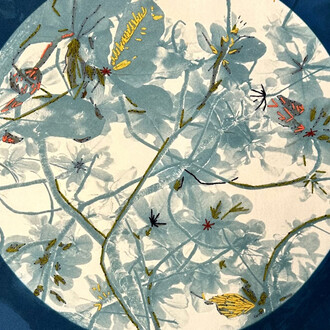Luis De Jesus Los Angeles is pleased to announce Ken Gonzales-Day: Afterlife, the artist’s sixth solo exhibition, on view in Gallery 1 and Gallery 2 from November 8 through December 20, 2025. An opening reception will take place on Saturday, November 8, from 4:00 to 7:00 pm.
Known for his conceptually driven photography and his investigations into race and historical memory, Gonzales-Day presents a new body of work that underscores the vital role of museum collections in celebrating the breadth of human experience. Drawing on his own cultural influences, he brings together objects from the Mexica and broader Mesoamerican traditions with those from Europe, Africa and Asia, foregrounding his intersectional perspective as a Queer Latinx artist. The exhibition's title, Afterlife, evokes the enduring afterlife of cultural objects, as both artistic expressions and historical artifacts within a larger cultural framework, while challenging the traditional narratives presented in museums.
Over the past 20 years, Gonzales-Day has photographed objects in museum collections and digitally reassembled them into new works. By combining these objects, Gonzales-Day creates playful and sometimes haunting images that are both timely and timeless, encouraging us to see our interconnectedness. The exhibition’s central piece, a large-scale photographic mural titled Xipe totec with busts, brings together images of busts of George Washington, Abraham Lincoln, Benjamin Franklin, and Susan B. Anthony (photographed during his residency at the Smithsonian American Art Museum and National Portrait Gallery) with Mexica and Mesoamerican objects, set amongst a deathly pile of skulls from the Museum of Criminal Anthropology in Turin. The work may incite reflection on the precarious state of museums and the battles being fought on both the cultural and global fronts.
Another series of works draw their inspiration from LACMA’s permanent collection, which served as the basis for the creation of a recently completed monumental public work entitled, Urban excavation: ancestors, avatars, bodhisattvas, buddhas, casts, copies, deities, figures, funerary objects, gods, guardians, mermaids, metaphors, mothers, possessions, sages, spirits, symbols, and other objects. It was commissioned by the Los Angeles MTA for the new D Line Subway Extension Wilshire/Fairfax Station. Here, Gonzales-Day uses museum objects as a starting point for artistic and cultural "excavation," aiming to recover and bring new life to works that may have been overlooked or silenced while also bringing attention to the lack of representation of Black, brown, queer, and other marginalized bodies in many museum collections, offering a critical and visual framework for rethinking these objects.
In another work, entitled Dying gaul/Chac mool, Gonzales-Day juxtaposes the iconic Dying gaul, a Roman copy of a lost Greek original, humanizing a so-called barbarian, with a Mesoamerican Chac Mool figure, a reclining stone sculpture associated with rituals of sacrifice and renewal.
It is a portal between worlds and reminds us that the line between art and life can be hard to separate. The two works echo one another, but unlike the myth of Narcissus, evoked by the composition, the reflection suggests that something unseen and powerful lies just beneath the surface—a subtle reference to Latinx communities in the U.S.
Ken Gonzales-Day: Afterlife is complemented by the artist’s first survey exhibition, Ken Gonzales-Day, History’s Nevermade, curated by Dr. Amelia Jones, on view at the USC Fisher Museum of Art through March 2026. It includes a fully illustrated catalogue featuring essays by leading scholars in art history, Latinx Studies, and visual culture.
















